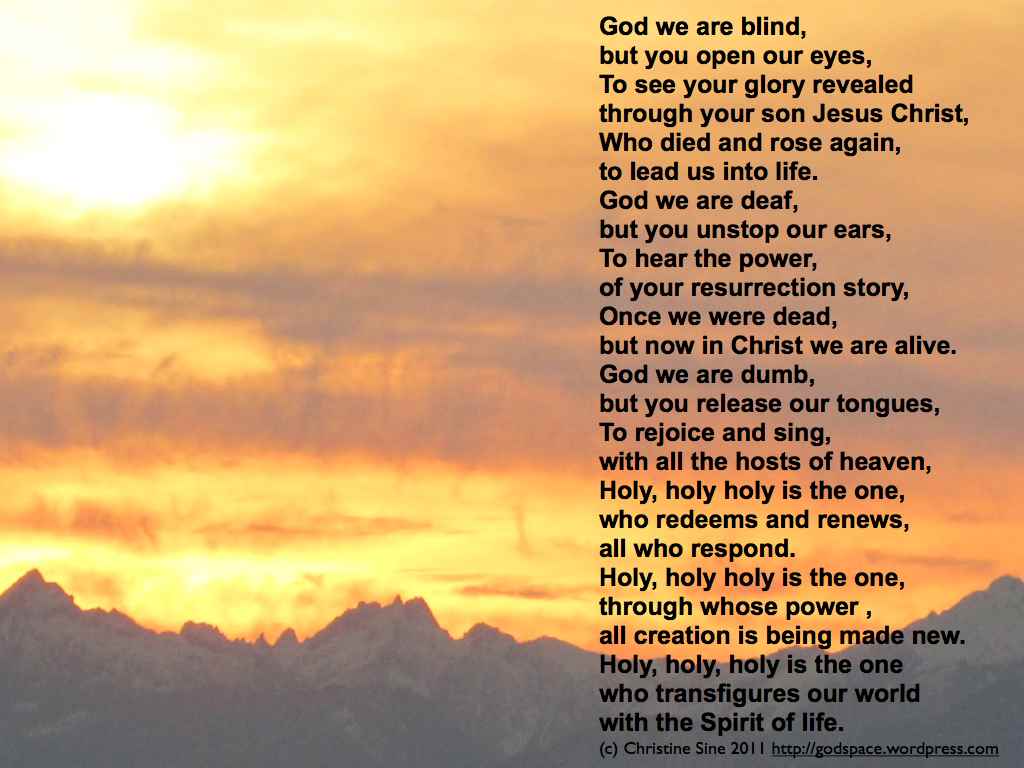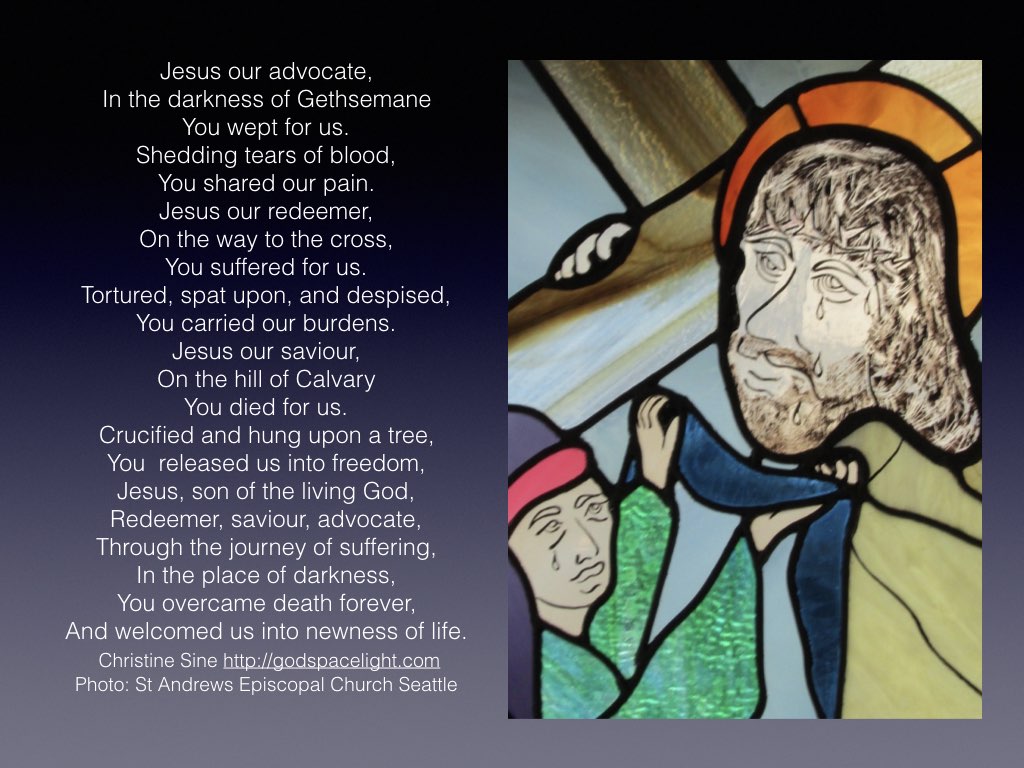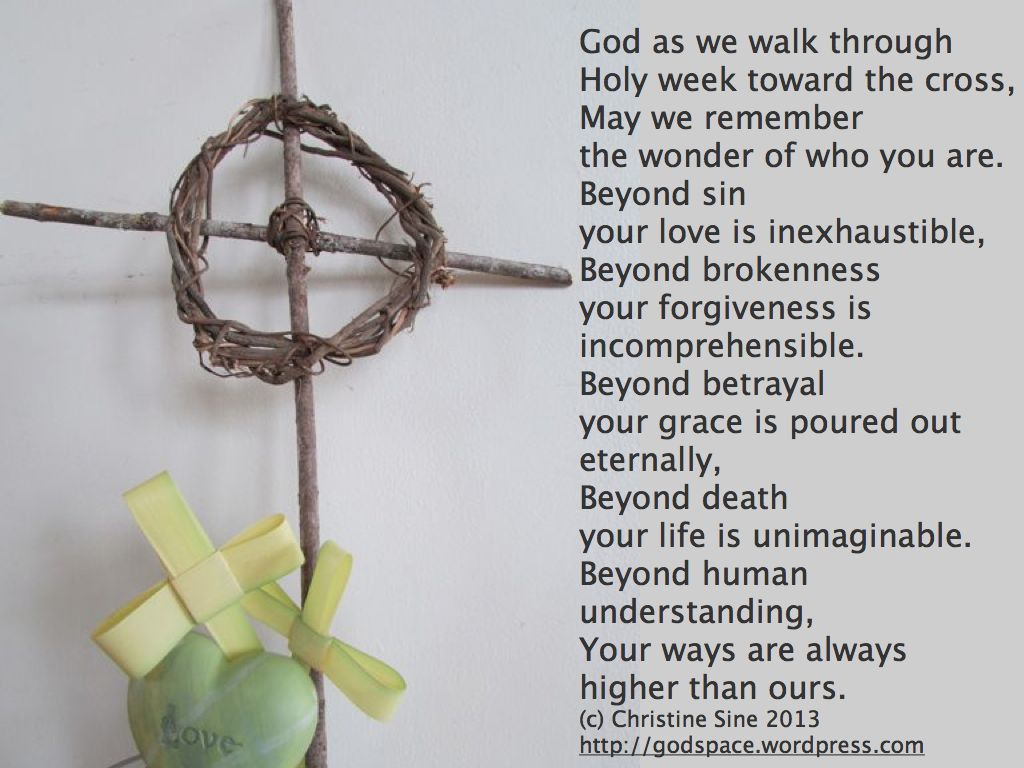At lunch time today Tom and I attended a Good Friday service at our local church. The service included the reading of the story of Jesus’ arrest and crucifixion from the gospel of John. What particularly struck me was the account of Jesus burial which tells us that Jesus body was laid in a new tomb in a nearby garden. It is planting time here in Seattle and so, not surprisingly, the imagery that came to my mind was of Jesus, like a seed of wheat, being planted in a garden, buried in the earth to await the birth of a new creation.
Far fetched you might think? Maybe not. Some theologians think that the whole theme of the Gospel of John is that of new creation. Most of the book of John (chapters 12-20) takes place during one week in the life of Christ. John concentrates on themes. One theme is that Christ will redeem all of Creation (not just souls) through Re-Creation. In many ways Jesus death was like the planting of a seed (Unless a seed is planted in the soil and dies it remains alone, but its death will produce many new seeds, a plentiful harvest of new lives (Jn 12:24). And then in John 20:15 we read: “she thought he was the gardener” Why did it matter that Mary Magdalene thought that Jesus was the gardener?
The gospel of John begins with the words “In the beginning”. This immediately harkens us to the book of Genesis which opens with the same words. John then lays out a series of events in the life of Christ that mirror the Seven Days of Creation. Read more
In the beginning God planted a garden – the Garden of Eden (Gen 3:8). In the beginning of the new creation brought into being by the resurrection of Christ God now in the form of the risen Christ, is once more seen as a gardener. The hope and promise of these words which we so often skim over is incredible. As we read in 2 Corinthians 5:17
“Therefore if anyone is in Christ he is a new creation, the old has passed away, behold, the new has come.”
So as we mourn the death of Christ today let us consider the hope that the planting of a seed gives us. It is but a dim mirror of the hope that resides in the Christ whose death we remember today and whose resurrection carries with us the promise of many lives renewed, restored and bearing fruit.
Song writer and musician Steve Bell has several beautiful posts for this holy weekend that I thought you might like to be aware of
This one for Good Friday features the song Gone is the Light
Gone is the Light
Music and lyric by Gord Johnson
appears on Steve Bell’s Devotion album (see below)
Into the darkness we must go
Gone, gone is the light
Into the darkness we must go
Gone, gone is the light
Jesus remember me
When you enter your Kingdom
Jesus remember me
When your kingdom comes
Father forgive them
They know not what they do
Father forgive them
They know not what they do
Into the darkness we must go
Gone, gone is the light
Into the darkness we must go
Gone gone is the light
And this one for Easter Sunday features another beautiful song Was It a Morning Like This.
Was it a Morning Like This | Jim Croegaert
Was it a morning like this
When the sun still hid from Jerusalem
And Mary rose from her bed
To tend the Lord she thought was dead
Was it a morning like this
When Mary walked down from Jerusalem
And two angels stood at the tomb
Bearers of news she would hear soon
chorus:
Did the grass sing
Did the earth rejoice to feel you again
Over and over like a trumpet underground
Did the earth seem to pound He is risen!
Over and over like in a never ending round
He is risen! Alleluia!
Was it a morning like this
When Peter and John ran from Jerusalem
And as they raced for the tomb
Beneath their feet was there a tune

This morning I posted this prayer on the Light for the Journey Facebook page.
Lord Jesus Christ today we are reminded
of how you knelt to wash our feet.
In a lowly act of service you poured out love.
Leading us away from power and prestige,
You showed us what true kingship looks like.
Earth shattering, profound,
A reversal of the status quo,
That we still struggle to imitate.
May we today follow your example.
May we kneel and wash the feet of others.
And in so doing share the wonder of your love.
The radical counter cultural nature of Jesus action is almost incomprehensible to us. A God who kneels to wash our feet as a servant. This was a job not just for a servant but for the lowliest of servants.
Two phrases stood out for me as I read the account of Jesus revolutionary action in John 13 this morning. He had loved his disciples during his ministry on earth and now he loved them to the very end. (v2) and I have given you an example to follow. Do as I have done to you. (v15)
All that Jesus has been trying to tell his disciples is summed up in this act of servanthood which John describes as one of the final acts of love Jesus shows towards his disciples. Don’t go after power, wealth and position. Don’t expect others to kneel and wash your feet, get down on your knees and wash theirs.
No wonder the import of this story usually passes us by. It has a part of a ceremony rather than a real act of life. But this is the prelude for the Last Supper. Perhaps it is the prerequisite for us truly being able to take communion together in the way that God intended us to.
So my question for all of us as we stand in the shadow of the cross today is: How can we too kneel and wash the feet of others today? How can we become more like the servants God intends us to be and so share the wonder of Christ’s love?
I posted this prayer on the Light for the Journey Facebook page this morning. Its popularity convinced me to add a photo and post it here as well. Enjoy
Susan Forshey just sent me this beautiful reflection with a link to the Booklet of prayers for which is a simple liturgy of the hours for Holy Week that she has produced. Enjoy and thanks Susan for sharing this with us.
A Prayer Booklet for Holy Week
With Palm Sunday, we enter into the Passion week, a Holy Week, remembering the Lord’s final days and building in anticipation toward the Resurrection.
For the world, this is much like any other week, and paradoxically, for ministers and others working in Christian contexts, it can be a week with little time for prayer and reflection.
To counter-act what feels like a break-neck race to Easter, I long to pause and rest in ‘unforced rhythms of grace’; to walk with Jesus through these days and let his Spirit transform my DNA; to practice a new way of thinking by remembering my small story in the midst The Story; to be patient on the hard days before the Glory, even as I learn to be patient in the whole of an often Holy Saturday life.
We live in death. We see it all around.
We live in-between. We are residents of the Now but Not yet of the coming Kingdom. We live in that moment of baptism, under the water, the moment between death and resurrection.
Yet we also live resurrected in promise and hope, taking in that wonderful first gasp of earthly air as we rise from the baptismal water. One day we will take in that full sweet heavenly breath as we rise with Jesus.
I’m a rushing wind through life right now, a whirlwind of activity blowing through, a Tasmanian Devil of the old cartoons, and I’m not remembering to breathe earth’s air, and even less of heaven.
Last night at 3am, I woke to blessed silence and lit a candle and made some tea and journalled the Spirit’s prayer in me: Your life is wonderful–two awesome jobs and a wonderful community–but it is not sustainable. Pray and reflect, but use your night hours to sleep and learn to pause during the day.
Let Me be the wind and you breathe Me.
I’ve read enough books on prayer and gotten myself into this kind of pickle too many times to know that pausing in the midst of being a one-woman tornado of activity is easier said than done.
But I also know that our rich prayer tradition offers centuries of helps for just such a situation.
One way to pause, to mark the days and hours of Holy Week, or any week, is to join with the wider Church in the Divine Office, or Liturgy of the Hours. For centuries, the Office was the prayer of Benedictine monks and sisters, but then the Office moved into the lives of laypeople.
This week I will take a couple moments to pause and pray the Hours. Would you join me?
Here is a simple Liturgy of the Hours for Morning, Noon, and Compline prayer, starting with Palm Sunday evening. It offers a pattern based on the full Liturgy of the Hours, some simple chants, and scripture passages from The Message translation of the Bible.
I invite you to mark this week with me as different from the world’s calendar, to enter into the Now, but Not Yet, to pause and rest, and breathe in the wind of the Spirit as we are caught up in our Savior’s story.
***
If you want to print the PDF, select the file and choose booklet settings on your printer. It should print two pages horizontally on 8.5 x 11 paper in the proper order so you can fold and staple it. Or enjoy it as a digital prayer book on your phone or tablet.
As an Amazon Associate, I receive a small amount for purchases made through appropriate links.
Thank you for supporting Godspace in this way.
When referencing or quoting Godspace Light, please be sure to include the Author (Christine Sine unless otherwise noted), the Title of the article or resource, the Source link where appropriate, and ©Godspacelight.com. Thank you!







